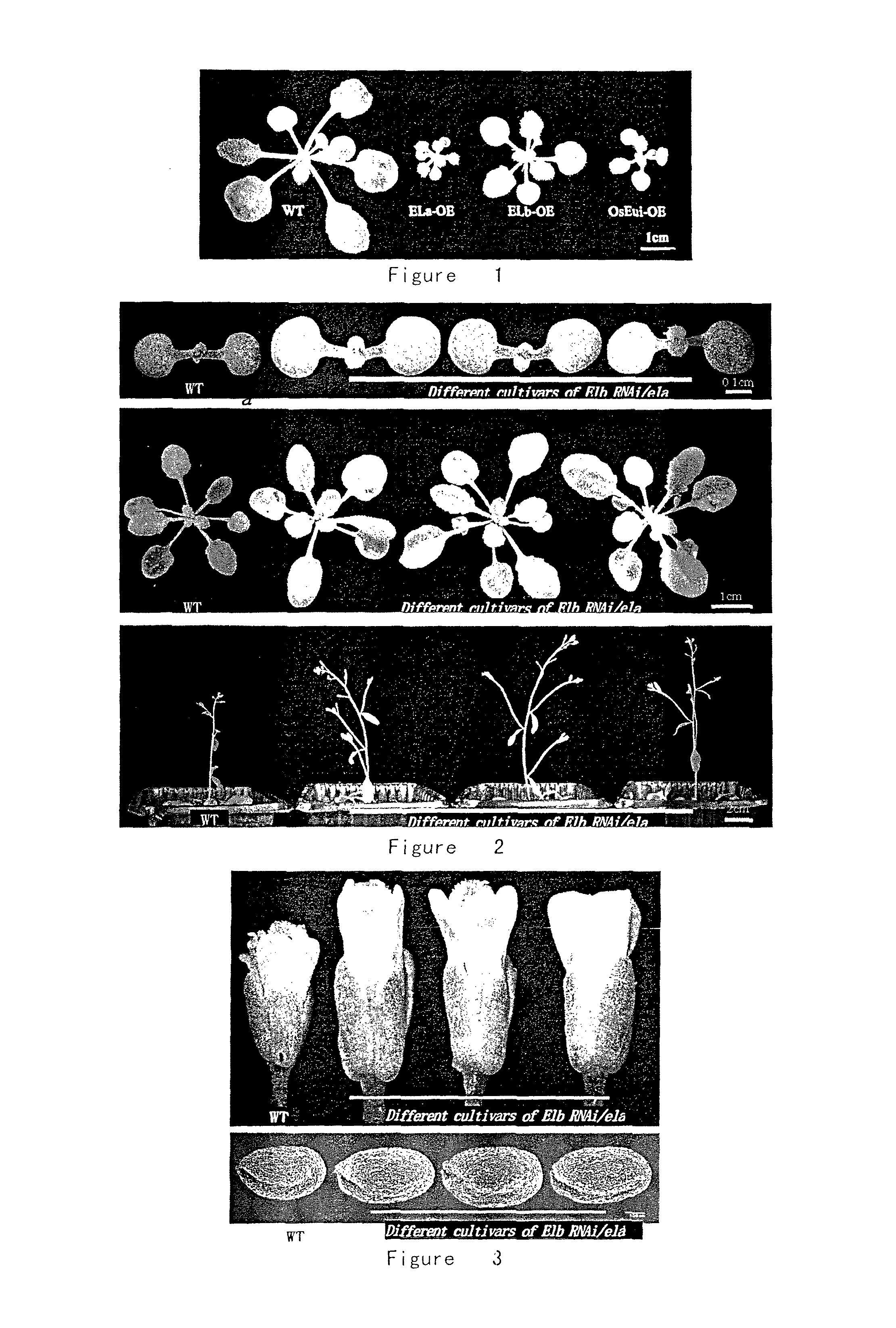Plant height regulatory gene and uses thereof
a plant height and regulatory gene technology, applied in the field of gene therapy and botany, can solve the problems of limiting the potential for higher yields, overheight of plants, and higher lodging tendency, and achieve the effects of reducing plant height and volume, enhancing expression or activity of the plant height regulatory gene, and increasing tillering and yield
- Summary
- Abstract
- Description
- Claims
- Application Information
AI Technical Summary
Benefits of technology
Problems solved by technology
Method used
Image
Examples
example 1
Cloning of ELb Gene
[0196]The inventor discovered 2 p450 monooxyganase genes, i.e., 714A1 and 714A2 bp searching the genomic sequences of Arabidopsis thaliana and performing bioinformatic research. They were initially predicted to involve in plant growth and development under the control of gibberellin, and designated as ELa (or AtEuila) and ELb (or AtEuilb) by the inventor.
[0197]The genomic DNA sequence of ELb gene coding region was set forth in SEQ ID NO:1; the cDNA sequence of ELb gene encoding region was set forth in SEQ ID NO:2; the ELb protein sequence was set forth in SEQ ID NO:3. The genomic sequence of ELa gene coding region was set forth in SEQ ID NO:4; the cDNA sequence of ELa gene coding region was set forth in SEQ ID NO:5; the ELa protein sequence was set forth in SEQ ID NO:6.
example 2
Decreased Plant Height and Volume in the Transgenic Arabidopsis thaliana Plants Overexpressing ELb Gene
[0198]In this example, the inventor prepared transgenic Arabidopsis thaliana plants that overexpressed ELb, ELa, or OsEui, respectively. The wild-type (WT) plant, a transgenic plant overexpressing Arabidopsis ELa (ELa-OE), and a transgenic plant overexpressing rice OsEui were used as controls.
[0199]The growth profiles were observed after 4 weeks of growth, and the results are shown in FIG. 1. As shown in the figure, the wild type Arabidopsis thaliana plant was the largest, the ELb over-expressing plant were substantially smaller than the wild type plant, and the ELa over-expressing plant and the OsEui overexpressing plant were the smallest.
[0200]After 7 weeks of growth, the inventor determined the plant height of wild type plant, and plants overexpressing ELb, ELa, and rice OsEui, and the average plant height values were 26.2 cm, 14.2 cm, 9.63 cm, and 3.7 cm, respectively. Therefor...
example 3
ELb RNAi or Knock-out Mutantion Increase Plant Height and Volume
[0201]In this example, the inventors prepared, starting with a plant variant that is an ELa T-DNA insertion mutant, ELb RNAi transgenic Arabidopsis thaliana plants (ELb RNAi / eLa) and Arabidopsis thaliana variant plants with ELb gene knocked out. After 10 days of growth of both plants, the effects of ELb RNAi or knock-out mutations on plant heights and volumes were observed, and compared with a wild type plant cultivated under the same condition as control.
[0202]The growth profiles of the ELb RNAi / eLa plants and the wild type plant were shown in FIG. 2. In comparison with the wild type plant, the leaf areas, plant heights, and volumes of the ELb RNAi / eLa plants were dramatically increased.
[0203]Moreover, in comparison with the wild type plant, the leaf areas, plant heights, and volumes of ELb knock-out mutants (in the background of ELa T-DNA insertion) were also dramatically increased.
[0204]Accordingly, it can be conclud...
PUM
| Property | Measurement | Unit |
|---|---|---|
| temperature | aaaaa | aaaaa |
| pH | aaaaa | aaaaa |
| v/v | aaaaa | aaaaa |
Abstract
Description
Claims
Application Information
 Login to view more
Login to view more - R&D Engineer
- R&D Manager
- IP Professional
- Industry Leading Data Capabilities
- Powerful AI technology
- Patent DNA Extraction
Browse by: Latest US Patents, China's latest patents, Technical Efficacy Thesaurus, Application Domain, Technology Topic.
© 2024 PatSnap. All rights reserved.Legal|Privacy policy|Modern Slavery Act Transparency Statement|Sitemap


